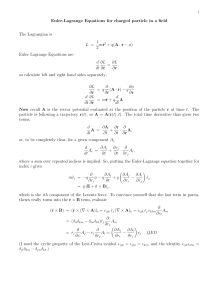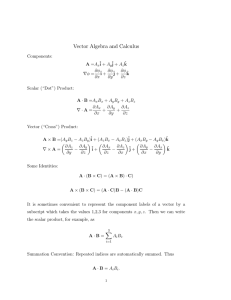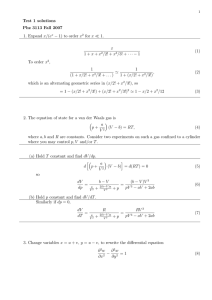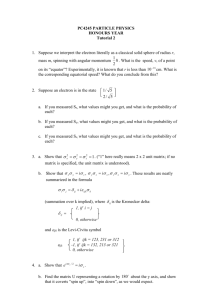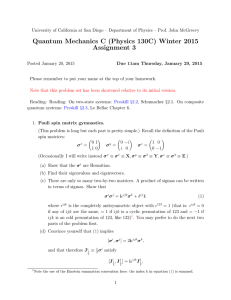22 - 1 Lecture
advertisement
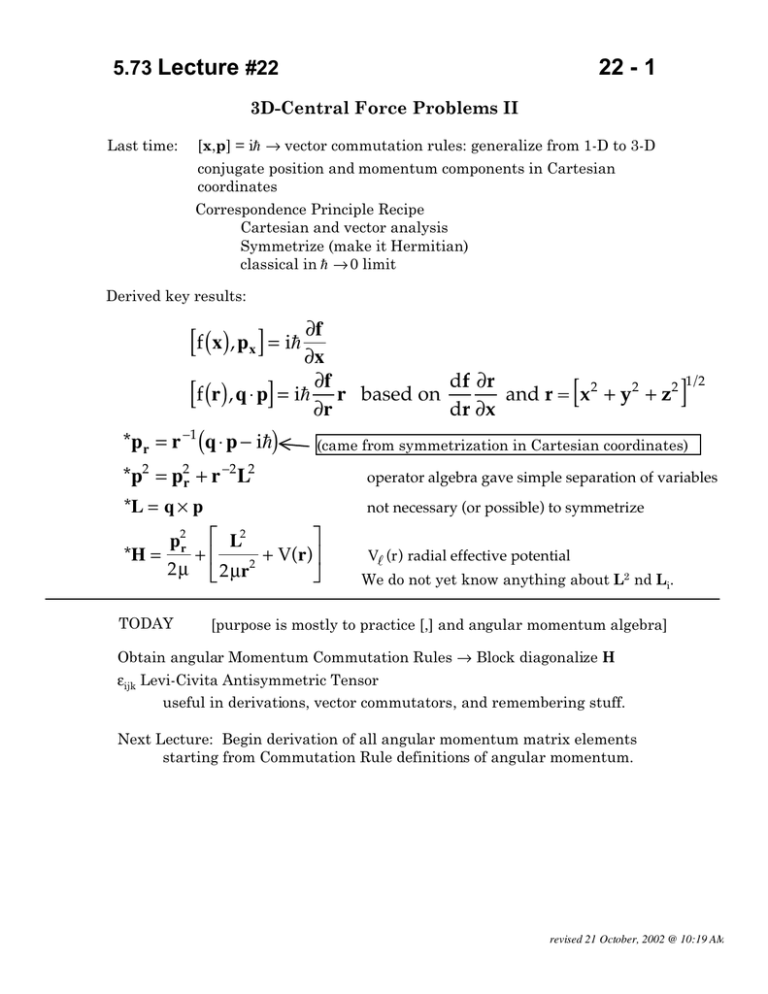
5.73 Lecture #22 22 - 1 3D-Central Force Problems II [x,p] = ih → vector commutation rules: generalize from 1-D to 3-D conjugate position and momentum components in Cartesian coordinates Last time: Correspondence Principle Recipe Cartesian and vector analysis Symmetrize (make it Hermitian) classical in h → 0 limit Derived key results: [f (x), px ] = ih ∂∂xf [ ] f (r ) , q ⋅ p = ih *pr = r −1 (q ⋅ p − ih) ∂f df ∂r r based on and r = x 2 + y2 + z2 ∂r dr ∂x [ ] 1/2 (came from symmetrization in Cartesian coordinates) *p2 = p2r + r −2 L2 operator algebra gave simple separation of variables *L = q × p not necessary (or possible) to symmetrize L2 V *H = + + ( r ) 2 µ 2 µr2 Vl (r ) radial effective potential p2r TODAY We do not yet know anything about L2 nd Li. [purpose is mostly to practice [,] and angular momentum algebra] Obtain angular Momentum Commutation Rules → Block diagonalize H εijk Levi-Civita Antisymmetric Tensor useful in derivations, vector commutators, and remembering stuff. Next Lecture: Begin derivation of all angular momentum matrix elements starting from Commutation Rule definitions of angular momentum. revised 21 October, 2002 @ 10:19 AM 5.73 Lecture #22 22 - 2 GOALS 1. 2. 3. 4. 5. [Li , f (r )] = 0 [Li , pr ] = 0 any scalar function of scalar r. difficult - need εijk [L , p ] = 0 [L , L ] = 0 ( but [L , L ] ≠ 0!) i 2 r 2 i i C.S.C.O. 2 j H , L2 , Li → block diagonalize H These 1-4 are chosen to show that all terms in H commute with L2 and Li 1. [Lz , f(r)] = [xpy − ypx , f(r)] = x[py , f ] + [x, f ]py − y[px , f ] − [y, f ]px [ x, f ] = 0, r [y, f ] = 0 because [q, f(r)] = 0 î + 0 ĵ + 0 k̂ ∂f ∂r ∂f x = ih ∂r ∂x ∂r r [Lz,f (r )] = −ih ∂∂fr x yr − y xr = 0 recall [f (r ), px ] = ih 2. [Lz , pr ] = [Lz , r −1 (q ⋅ p −0 ih)] = [Lz , r −1q ⋅ p] = [L z , r −1 ]q ⋅ p + r −1 [L z , q ⋅ p] r r [Lz , q ⋅ p] = q ⋅ [Lz , p] + [Lz , q] ⋅ p two vector commutators on RHS r Note that q is not f(r )! need to define special notational trick to evaluate these DIFFICULT COMMUTATORS revised 21 October, 2002 @ 10:19 AM 5.73 Lecture #22 22 - 3 ε ijk Levi-Civita Symbol adjacent interchange ε xyz = ε yzx = ε zxy = +1 ε yxz = ε zyx = ε xzy = −1 2 repeated indices ε xxy = etc.= 0 cyclic order [ ] I claim L i , p j = ih ∑ ε ijk pk . This will become the definition of a “vector operator” k with respect to L. Nonlecture: Verify claim for 1 of 3 × 3 = 9 possible cases let i = x, j = y [Lx ,py ] = [ypz − zpy ,py ] = [ypz ,py ] + 0 0 = [y,py ]pz + y[pz ,py ] = ihpz Now check this using εijk [L ,p ] = ih∑ ε x y xyk [ 0 0 pk = ih ε xyx px + ε xyy py + ε xyzpz k = ihpz . ] OK All other 8 cases go similarly Other important Commutation Rules [Li ,p j ] = ih∑k ε ijkpk [Li ,q j ] = ih∑k ε ijkq k [Li ,L j ] = ih∑k ε ijk Lk general definition of a “vector” operator general definition of an “angular momentum.” Works even for spin where q × p definition is inapplicable All angular momentum matrix elements will be derived from these commutation rules. FOR THE READER: VERIFY ONE COMPONENT OF EACH OF THE THREE ABOVE COMMUTATORS revised 21 October, 2002 @ 10:19 AM 5.73 Lecture #22 22 - 4 [Li ,L j ] = ih∑k ε ijk Lk is identical to L × L = ihL r r expect 0! because vector cross product A × B = | A || B | sin θeˆ AB ( ) î ĵ k̂ L × L = L x L y Lz = î L y Lz − Lz L y + ĵ Lz L x − L x Lz + k̂ L x L y − L y L x L L L x y z [ ] = ih îL x + ĵL y + k̂Lz = ihL This vector cross product definition of L is more general than q × p because there is no way to define spin in q × p form but S × S = ihS is quite meaningful. Can one generalize that, if L × L = ihL (instead of 0), and the [Li, Lj] and [Li, pj] commutation rules have similar forms, that L × p = ihp? NO! Check for yourself! 2. Continued. [L ,p ] = r q ⋅ [L ,pr ] + r [L ,qr ] ⋅ p r L p , [ ] = ih∑ (ˆi ε + ˆjε + kˆ ε )p −1 z −1 r z i ixk sum of 3 terms k vector commutators z iyk izk k r q ⋅ [L i , p] = ih ∑ xε ixk + yε iyk + zε izk pk k ( = ih ∑ ε ijk q jpk ) only one of these terms is nonzero (1) j, k revised 21 October, 2002 @ 10:19 AM 5.73 Lecture #22 22 - 5 r r and the other term [L i , q ] ⋅ p [L ,qr ] = ih∑ i k [ˆi ε [L ,qr ] ⋅ p = ih∑ [ε i ixk ixk ] + ˆj ε iyk + kˆ ε izk qk qk px + ε iyk qk py + ε izk qk pz k = ih ∑ ε ijk qk p j = ih ∑ ε ikjq jpk j, k ] (k↔ (k↔j labels permuted) k, j = −ih ∑ ε ijk q jpk k, j (2) switch order of j and k putting Eqs. (1) and (2) together [ ] q ⋅ [L i ,p] + [L i ,q ] ⋅ p = ih ∑ ε ijk q jp k − ε ijk q jp k = 0! j,k Elegance and power of εijk notation! We have shown that: * [Li,pr] = 0 for all i * easy now to show [Li,pr2] = 0 [ ] j( [ ] j[ ] ] ] [ Finally L i ,L2 = ∑ L i ,L2j = ∑ L j L i ,L j + L i ,L j L j = ∑ L j ih Σ ε ijk L k + ih Σ ε ijk L k L j k k j same trick: permute j ↔ k indices in second term εijk = −εikj − ih Σ ε ijk L j L k k =0 [ ] [ ] [ ] But be careful: L i ,L2j = L j L i ,L j + L i ,L j L j = ih L j Σ ε ijk L k + Σ ε ijk L k L j k k because this is a sum only over k, so can’t combine and cancel terms. revised 21 October, 2002 @ 10:19 AM 5.73 Lecture #22 22 - 6 for i = x, j = y [L ,L ] = ih[L L x 2 y y z ] + Lz L y ≠ 0! so we have shown [L2 ,Li ] = 0 [L2 ,f(r)] = 0 [Li ,f(r)] = 0 [L2 ,pr ] = 0 [Li ,pr ] = 0 ∴ L2, Li, H all commute — Complete Set of Mutually Commuting Operators eigenfunction of L2 with eigenvalue h 2 L( L + 1) So what does this tell us about L H L ′ = ? BLOCK DIAGONALIZATION OF H! ψ = χ ( r ) L2 , L z = nLM L Basis functions radial special angular universal eigenfunctions of Lz eigenfunctions of L2 which radial eigenfunction? Next time I will show, starting from [L ,L ] = ih Σ ε i j k ijk Lk , that * L2 nLM L = h 2L (L + 1) nLM L L = 0,1,… * L z nLM L = hM L nLM L M L = −L, −L + 1,… + L also derive all L x and L y matrix elements in nLM L basis set. revised 21 October, 2002 @ 10:19 AM
